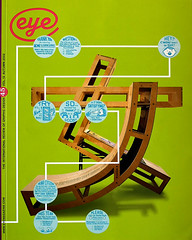Autumn 2002
Porn?
Can sexual image-making escape the stigma of porn? Critique by Rick Poynor
The other day I saw a man in a bookshop – the ICA bookshop in London, to be precise – impulse-buy a book on the strength of no more than its title and cover design. The pink, padded volume was sealed in a cellophane wrapper, like all the other copies, and the man didn’t ask whether he could unwrap it, though he did ask the sales assistant whether the book was any good. The assistant wouldn’t offer an opinion one way or the other, but the man bought it regardless. The book was Porn?.
Did it deliver the goods? That will probably depend on how closely he paid attention to that question mark and, more pointedly, to the typography of the single word on the cover set in one of Louis John Pouchée’s decorative alphabets (see Eye no. 15 vol. 4). Using a pre-Victorian display type ornamented with Edenic bunches of fruit to signal the twenty-first century’s favourite growth industry is a wonderfully sardonic touch.
Porn?, conceived by Tom Hingston Studio and Dazed & Confused magazine and published by Vision On, offers a plethora of porn-related projects by photographers and a few artists. Try as it might, the book confirms just how hard it is to say anything new about the subject, especially if our shared starting point, both emotionally and literally, is that we’ve seen it all before. While art might once have been the medium by which many encountered sexually provocative material, it has been left in the dust by the Internet’s power to pump 24-hour ‘transgression’ into our homes. That’s probably why some of these image-makers prefer to arrive on the scene, like clue-seeking detectives, after events have transpired. Anuschka Blommers and Niels Schumm show used condoms littering patches of bare ground; Larry Sultan pictures the empty sets and locations, the furniture and mattresses, where porn gets made.
If these images suggest something deeply forlorn in our hyper-sexualised culture, others revel in more ambiguous forms of distaste. Sølve Sundsbø digitally grafts women’s heads on to the bodies of men grasping their cocks and splatters the images with hideous typographic cum-ons. In one of the most telling projects, fashion stylist Simon Foxton and designer Stephen Male construct a series of convincingly real fake porn mag covers complete with coverlines – Prostitute Weekly, Meat Pie, Cucumbers and Beauty (‘This issue: birth defects special’). Yes, there’s something for everyone out there in ‘Pornoland’ – as Mark Irving dubs it in his languidly non-judgemental introductory essay. Is it just me, or would risking a little judgement – pro or anti – be a more interesting and productive position to take at this point?
The more avidly we peer at porn, and the more we claim, if only by implication, to enjoy this peering, the less we seem to want to consider what it might be doing to us. By transcribing advertising copy – ‘Transexual sluts’, ‘1-800 teen clit’ – on to drawings of anxious men, Paul Davis hints at the psychic cost of porn’s routine, dehumanising callousness.
There is very little actual sex in Porn?. Perhaps it seemed too obvious. On the other hand, in the current climate, showing active genitalia and asking whether such an image must necessarily be porn is a truly revealing question. What is it that makes porn ‘porn’? Is it the mere fact of showing explicit sex? Is it a certain attitude on the part of the makers, the seller, the buyer? If it’s the buying itself that makes it porn, then this book is porn. Is it a question of how you use it? – if it makes you come, then it’s porn. Or is it, more subtly, a question of codes of representation, the way the images are conceived and shot? Porn often shows ugly things, but it also shows them in an ugly way (some might like that, of course). Harsh, unmodulated lighting, negligible compositional skills. The images purport to be representations of ‘pleasure’, but in their brutal mechanics, they convey little understanding of what pleasure means.
Sean Ellis applies the kind of photographic values to fucking that you would normally see in an ad. In some ways, his pictures observe the conventions of the glossier kind of porn. The woman wears stockings and shoes and the man is reduced to a hard-on. They look more like ads for sex than sex itself, but they have a beauty and a conviction that is startling in this visually degraded context. In form if not outlook, they suggest the possibility of a sexual image-making that escapes the generic constraints and stigma of porn. Or is this to overstate the significance of style?
Rick Poynor, writer, founding editor of Eye, London
First published in Eye no. 45 vol. 12, 2002
Eye is the world’s most beautiful and collectable graphic design journal, published quarterly for professional designers, students and anyone interested in critical, informed writing about graphic design and visual culture. It is available from all good design bookshops and online at the Eye shop, where you can buy subscriptions and single issues.

